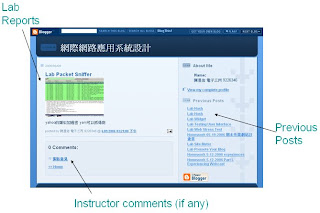Blog create a context for dialogues between bloggers and readers.Most blog platforms provide a personal writing space that is easy to publish, sharable.Blogs can combine solitary and social interaction in the learning processes .Considerable research has been carried out on the educational use of blogs (Richardson, 2006;Williams and Jacobs, 2004; Oravec, 2002;Dailey 2006).
2.Blogs as Learning
Social construction of knowledge through social media such blogs help explain why assessing other’s work may be conducive to social learning.In this sense, blogs have the potentials to upgrade personal learning to social learning. For the purpose of promoting critical and analytical thinking, after a student has read another’s posting, she is asked to leave comment to that posting. We call it the creation of “dialogue links” that are different from the trackback links (Figure 1).

Figure 1. The formation of social learning circles by creating not just trackback links but also dialogue links in blogs.
3.Social Media Experiments
Platform : The Blog in our study is based on the platform of Blogger at http://www.blogger.com/ which is now a property of Google.
Procedure: First of all, student took a tour to a local science fair.A short essay was written by each student .After the essay was finished, each student was asked to browse their peers’ work and make at least 3 comments on others’ essays(Figure 2) .Conducting social network analysis to investigate the student behaviors in terms of social learning.

Table 1 : Metrics of Social Learning

Figure 3: Distribution of numbers of comments versus counts.
Limitations
The results reported are limited as following reasons .
- The sample size was small
- The context of learning was narrowly define.
- Blogging acted as a supplement to a traditional face-to-face course.
- The social network analysis measures the online community of practice from a structure point of view.
Therefore, We conduct a survey study on a larger sample and collect data regarding non-structural issues .
4. User Survey
Sample Three undergraduate classes, namely Electronic Commerce, Java Programming Language and Programming for Internet Applications, with 23, 38 and 36 students respectively.
Divided into D-Group with 48 samples and S-Group with 23 samples.
Procedure
D group emphasizes the use of blog as an express lane of delivering finished work for the instructor to check out immediately.
S group sees the blogs as idea sharing platform, namely encourages students to read peer blogs and make comments. The questionnaire was poised by a score on a 5-point scale.
All the questionnaires are administrated anonymously by a third party without the instructor on the spot. The following five hypotheses are coded in the questionnaire and tested in the survey administrated to the two groups.
Hypothesis 1: Blogging helps students feel more connected and interactive with classmates.
Hypothesis 2: Blogging helps students more engaged and interested in the subjects covered by the courses .
Hypothesis 3: Blogging improved the quality and experience of learning .
Hypothesis 4: Students take a look at people’s homework first when they don’t have a clue to the problems.
Hypothesis 5: Students uphold the principle of honesty and make no duplicates of people’s homework, although students may read it at times.
4.1Summary of Survey
According to Table 2., the mean of Hypothesis 1 is greater then 3, and the other four hypotheses receive means with value greater then 4. The effects of blogging on learning are supported.
Table 2. Survey results regarding the tree classes.

Table 3 : t-test results of S-Group and D-Group
Further conduct the t-testto assess whether the means of the two groups are statistically different from each other. The results are summarized in Table 3.
Regarding Hypotheses 1, 2 and 3, blogs of the S-Group as tools for social construction help build more sense of community , and better improve experiences of learning than those in D-Group.
Except for Hypothesis 4, the means of two groups are statistically different . For Hypothesis 4, the difference in two groups is not significant. It indicates that no matter which of the two ways the blogs are used to support learning acitvities, both groups recognize the possibility of blogs as repository of clues to solve problems.
For Hypothesis 5, both groups show positive signs regarding the principle of honesty .It is worth of noting that the S group is more aware of the ethics issues than the other group.
Conclusions
Using blogs is found to simplify the tasks of reducing piracy.
Blogs are a viable platform for ideas to flat and grow.
Blags are easy to maintain, low cost, easy to deploy, and simple to get started.









